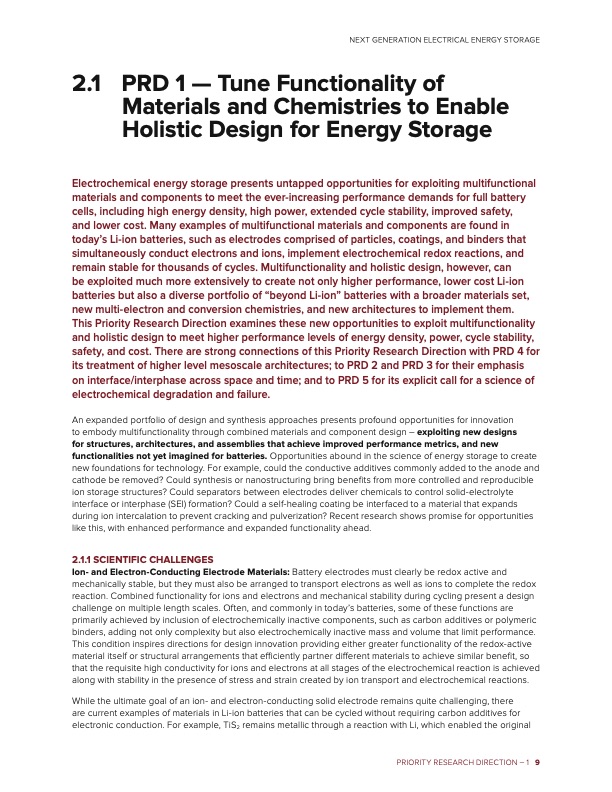
PDF Publication Title:
Text from PDF Page: 015
2.1 PRD 1 — Tune Functionality of Materials and Chemistries to Enable Holistic Design for Energy Storage Electrochemical energy storage presents untapped opportunities for exploiting multifunctional materials and components to meet the ever-increasing performance demands for full battery cells, including high energy density, high power, extended cycle stability, improved safety, and lower cost. Many examples of multifunctional materials and components are found in today’s Li-ion batteries, such as electrodes comprised of particles, coatings, and binders that simultaneously conduct electrons and ions, implement electrochemical redox reactions, and remain stable for thousands of cycles. Multifunctionality and holistic design, however, can be exploited much more extensively to create not only higher performance, lower cost Li-ion batteries but also a diverse portfolio of “beyond Li-ion” batteries with a broader materials set, new multi-electron and conversion chemistries, and new architectures to implement them. This Priority Research Direction examines these new opportunities to exploit multifunctionality and holistic design to meet higher performance levels of energy density, power, cycle stability, safety, and cost. There are strong connections of this Priority Research Direction with PRD 4 for its treatment of higher level mesoscale architectures; to PRD 2 and PRD 3 for their emphasis on interface/interphase across space and time; and to PRD 5 for its explicit call for a science of electrochemical degradation and failure. An expanded portfolio of design and synthesis approaches presents profound opportunities for innovation to embody multifunctionality through combined materials and component design – exploiting new designs for structures, architectures, and assemblies that achieve improved performance metrics, and new functionalities not yet imagined for batteries. Opportunities abound in the science of energy storage to create new foundations for technology. For example, could the conductive additives commonly added to the anode and cathode be removed? Could synthesis or nanostructuring bring benefits from more controlled and reproducible ion storage structures? Could separators between electrodes deliver chemicals to control solid-electrolyte interface or interphase (SEI) formation? Could a self-healing coating be interfaced to a material that expands during ion intercalation to prevent cracking and pulverization? Recent research shows promise for opportunities like this, with enhanced performance and expanded functionality ahead. 2.1.1 SCIENTIFIC CHALLENGES Ion- and Electron-Conducting Electrode Materials: Battery electrodes must clearly be redox active and mechanically stable, but they must also be arranged to transport electrons as well as ions to complete the redox reaction. Combined functionality for ions and electrons and mechanical stability during cycling present a design challenge on multiple length scales. Often, and commonly in today’s batteries, some of these functions are primarily achieved by inclusion of electrochemically inactive components, such as carbon additives or polymeric binders, adding not only complexity but also electrochemically inactive mass and volume that limit performance. This condition inspires directions for design innovation providing either greater functionality of the redox-active material itself or structural arrangements that efficiently partner different materials to achieve similar benefit, so that the requisite high conductivity for ions and electrons at all stages of the electrochemical reaction is achieved along with stability in the presence of stress and strain created by ion transport and electrochemical reactions. While the ultimate goal of an ion- and electron-conducting solid electrode remains quite challenging, there are current examples of materials in Li-ion batteries that can be cycled without requiring carbon additives for electronic conduction. For example, TiS2 remains metallic through a reaction with Li, which enabled the original NEXT GENERATION ELECTRICAL ENERGY STORAGE PRIORITY RESEARCH DIRECTION – 1 9PDF Image | Next Generation Electrical Energy Storage

PDF Search Title:
Next Generation Electrical Energy StorageOriginal File Name Searched:
BRN-NGEES_rpt-low-res.pdfDIY PDF Search: Google It | Yahoo | Bing
Sulfur Deposition on Carbon Nanofibers using Supercritical CO2 Sulfur Deposition on Carbon Nanofibers using Supercritical CO2. Gamma sulfur also known as mother of pearl sulfur and nacreous sulfur... More Info
CO2 Organic Rankine Cycle Experimenter Platform The supercritical CO2 phase change system is both a heat pump and organic rankine cycle which can be used for those purposes and as a supercritical extractor for advanced subcritical and supercritical extraction technology. Uses include producing nanoparticles, precious metal CO2 extraction, lithium battery recycling, and other applications... More Info
| CONTACT TEL: 608-238-6001 Email: greg@infinityturbine.com | RSS | AMP |